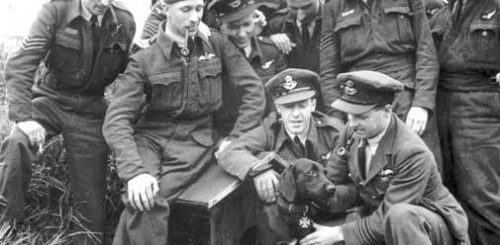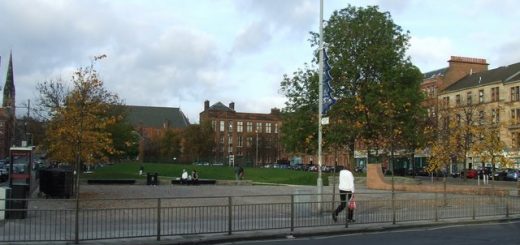Park Place, Remenham
Park Place is a Grade II listed building which in 2011 became the most expensive home sold in Britain with a huge £140m price tag. Dating from the early 18th century it is not surprising that there are also a few ghosts and legends attached to the site.
The house known as Park Place was built by Lord Archibald Hamilton of Riccarton and Pardovan (Baptized 17 February 1673 – Died 5 April 1754) who purchased the land from Mrs Elizabeth Baker. Throughout his career Hamilton had been a Navy Captain, a Member of Parliament (for Lanarkshire, Queenborough and Dartmouth) Governor of Jamaica, a Lord of the Admiralty (1729-1738) and Governor of Greenwich Hospital (1746 – 1754).
 It was bought by Frederick, Prince of Wales (Born 1 February 1707 – Died 20 March 1751) in 1738. Lord Hamilton’s third wife, Lady Jane Hamilton (Born 1699 – Died 1753) (the daughter of James Hamilton, 6th Earl of Abercorn) was Mistress of the Robes to Augusta, Princess of Wales between (1736 -1745) and also the mistress of Frederick, Prince of Wales.
It was bought by Frederick, Prince of Wales (Born 1 February 1707 – Died 20 March 1751) in 1738. Lord Hamilton’s third wife, Lady Jane Hamilton (Born 1699 – Died 1753) (the daughter of James Hamilton, 6th Earl of Abercorn) was Mistress of the Robes to Augusta, Princess of Wales between (1736 -1745) and also the mistress of Frederick, Prince of Wales.
Following the death of the Prince of Wales which was caused by a burst abscess in his lung, Park Place was sold to Henry Seymour Conway (Born 1721 – Died 9 July 1795) in 1752. Conway was a soldier and statesman who in 1793 attained the rank of Field Marshal. During his time at Park Place he made several improvements. According to A History of the County of Berkshire: Volume 3 (1923) ‘Henry Seymour Conway, who started the cultivation of lavender in Remenham and established a distillery there. The house, which he had much improved, became the rendezvous of many distinguished people, among whom were Horace Walpole, David Hume, the poet Gray, and Mrs. Damer the sculptress, who carved the keystones of Henley Bridge. The grounds were laid out by Conway according to the taste of the period. At the upper end of the Happy Valley in the park was placed a Grecian ruin built of stones brought from Reading Abbey, and stones frome the same place were used to build and stones from the same place were used to build the bridge over the valley which carried the road from Henley to Wargrave (Conway’s Bridge). On a hill beyond the pleasure grounds was a Druidic temple presented to Conway by the inhabitants of Jersey (where it was found near St. Helier in 1785), when he was governor of that island.’
The diplomat, James Harris, First Earl of Malmesbury (Born 21 April 1746 – Died 21 November 1820) bought Park Place in 1797 and auctioned the estate in 1816 when it was purchased by Henry Piper Sperling.
In 1824 Ebenezer Fuller-Maitland (Born 23 April 1780 – Died 1 November 1858) traded Norbury Park for Park Place from his cousin Sperling. Maitland was a Member of Parliament and the son of a director of the Bank of England who inherited a substantial amount of money when he married.
Following Ebernezer’s death Queen Victoria considered buying Park Place, but for whatever reason this did not happen. Ebernezer’s widow, Bethia Ellis (Born 1781 – Died 1865) remained there until her death when their son William Fuller-Maitland (Born 19 April 1813 – Died March 1876) took possession.
William also of Stansted Hall, Essex, sold Park Place in 1867 to Charles Easton of Whiteknights for £71,400. Easton was a speculator with plans of splitting up the estate. He altered the house, pulling down the library. In 1869/1870 Park Place was purchased by John Noble of Noble’s Paints & Varnishes. A fire destroyed much of the house’s interior in 1870/1871 and Noble hired Thomas Cundy to rebuild it. Nikolaus Pevesner (1966) description of Park Place; ‘The present house is by Thomas Cundy, 1870, in a rather dreary French Renaissance Style with a tower over one corner of the facade and Pavallion roofs. This house takes the place of that of the Conway family, and the interest of Park Place is its grounds as beautified by General Conway, who bought the estate in 1752, in his time the grounds were 900 acres in size.’
Noble’s estate was 670 acre and remained in the family until 1947 when it was divided into twenty lots and put up for auction at Henley Town Hall. Park Place was bought by Middlesex County Council and used as a boarding school for children suffering from health or emotional problems. It was transferred to Hillingdon Council in 1965 and closed in 1988, before being sold back to a private owner.
Mike Spink bought Park Place in 2007, after it appeared in the film St Trinians. After spending a reputed £100 million restoring the estate and house, he sold it in 2011 to an anonymous Russian buyer for £140 million.
Ghosts?
Given the prominent historic owners of Park Place and their numerous famous guests over the centuries it is not surprising that a few stories exist concerning the estate. I must admit though that I have not heard of any tales concerning the house itself.
It has been suggested that the 18th Century poisoner of Henley on Thames, Mary Blandy haunts the grounds of Park Place as she used to walk here with her lover Captain William Henry Cranstoun.
Another 18th Century story relates a group of gypsies camping on the estate with plans to break into the house. There plan was discovered by a young shepherd who raised the alarm. Seeking revenge the gypsies seized the shepherd one night, skinned him alive and left him to die in a ditch on the estate. He was found and was able to identify his attackers before he died. Yew trees are planted around the ditch where the youth was left and his ghost is said to haunt that area.
I don’t know if there are any genuine witness accounts of these ghosts or whether they are just stories created to scare unwanted people away from the grounds after dark.




Recent Comments